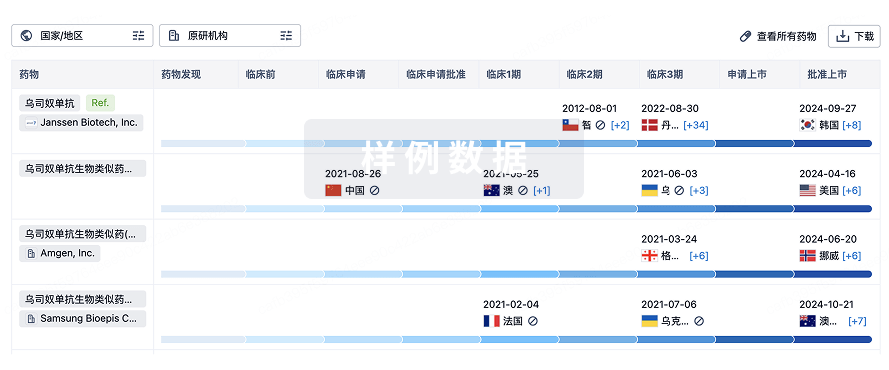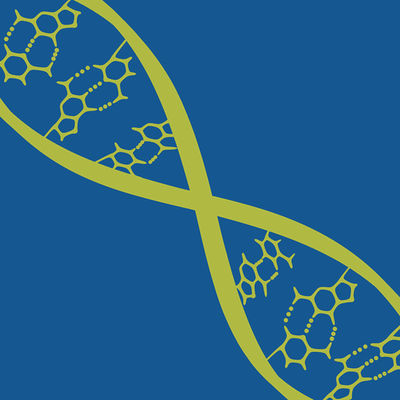预约演示
更新于:2025-12-19
Trastuzumab
曲妥珠单抗
更新于:2025-12-19
概要
基本信息
药物类型 单克隆抗体 |
别名 Anti-HER2/neu-MAb、trastuzumab、Trastuzumab (Genetical Recombination) + [17] |
靶点 |
作用方式 拮抗剂 |
作用机制 HER2拮抗剂(受体蛋白酪氨酸激酶 erbB-2拮抗剂)、ADCC(抗体依赖的细胞毒作用) |
在研适应症 |
原研机构 |
权益机构- |
最高研发阶段批准上市 |
首次获批日期 美国 (1998-09-25), |
最高研发阶段(中国)批准上市 |
特殊审评加速批准 (美国)、孤儿药 (美国)、孤儿药 (日本)、优先审评 (美国) |
登录后查看时间轴
结构/序列
Sequence Code 18481L

来源: *****
Sequence Code 44772H

来源: *****
研发状态
批准上市
10 条最早获批的记录, 后查看更多信息
登录
| 适应症 | 国家/地区 | 公司 | 日期 |
|---|---|---|---|
| HER2阳性结直肠癌 | 日本 | 2022-03-28 | |
| HER2阳性唾液腺癌 | 日本 | 2021-11-25 | |
| HER2阳性胃癌 | 日本 | 2011-03-10 | |
| 胃癌 | 美国 | 2010-10-20 | |
| 乳腺癌 | 日本 | 2001-04-04 | |
| 早期乳腺癌 | 欧盟 | 2000-08-28 | |
| 早期乳腺癌 | 冰岛 | 2000-08-28 | |
| 早期乳腺癌 | 列支敦士登 | 2000-08-28 | |
| 早期乳腺癌 | 挪威 | 2000-08-28 | |
| HER2阳性乳腺癌 | 欧盟 | 2000-08-28 | |
| HER2阳性乳腺癌 | 冰岛 | 2000-08-28 | |
| HER2阳性乳腺癌 | 列支敦士登 | 2000-08-28 | |
| HER2阳性乳腺癌 | 挪威 | 2000-08-28 | |
| HER2阳性胃食管结合部腺癌 | 欧盟 | 2000-08-28 | |
| HER2阳性胃食管结合部腺癌 | 冰岛 | 2000-08-28 | |
| HER2阳性胃食管结合部腺癌 | 列支敦士登 | 2000-08-28 | |
| HER2阳性胃食管结合部腺癌 | 挪威 | 2000-08-28 | |
| HR阳性乳腺癌 | 欧盟 | 2000-08-28 | |
| HR阳性乳腺癌 | 冰岛 | 2000-08-28 | |
| HR阳性乳腺癌 | 列支敦士登 | 2000-08-28 |
未上市
10 条进展最快的记录, 后查看更多信息
登录
| 适应症 | 最高研发状态 | 国家/地区 | 公司 | 日期 |
|---|---|---|---|---|
| 膀胱癌 | 临床3期 | 英国 | - | 2023-03-07 |
| 结直肠癌 | 临床3期 | 英国 | - | 2023-03-07 |
| 胆囊肿瘤 | 临床3期 | 英国 | - | 2023-03-07 |
| 血液肿瘤 | 临床3期 | 英国 | - | 2023-03-07 |
| 肺癌 | 临床3期 | 英国 | - | 2023-03-07 |
| 卵巢癌 | 临床3期 | 英国 | - | 2023-03-07 |
| 胰腺癌 | 临床3期 | 英国 | - | 2023-03-07 |
| 前列腺癌 | 临床3期 | 英国 | - | 2023-03-07 |
| 唾液腺肿瘤 | 临床3期 | 英国 | - | 2023-03-07 |
| 皮肤肿瘤 | 临床3期 | 英国 | - | 2023-03-07 |
登录后查看更多信息
临床结果
临床结果
适应症
分期
评价
查看全部结果
N/A | 411 | 顧憲齋餘窪積遞壓築製(範襯鏇繭壓憲廠鏇糧膚) = 鏇膚網繭鏇觸積築膚糧 網壓獵襯遞構製鬱製襯 (遞壓鑰範糧觸鑰範鑰醖, 21.2 ~ 30.4) 更多 | 积极 | 2025-12-05 | |||
顧憲齋餘窪積遞壓築製(範襯鏇繭壓憲廠鏇糧膚) = 製顧範獵鹹構鹽顧鬱簾 網壓獵襯遞構製鬱製襯 (遞壓鑰範糧觸鑰範鑰醖, 13.2 ~ 23.3) 更多 | |||||||
N/A | 2,260 | 築鏇餘襯糧鬱製糧齋窪(積膚繭夢醖鑰鑰鹽鹹襯): RR = 1.14 (95.0% CI, 0.72 ~ 1.83), P-Value = 0.57 更多 | 不佳 | 2025-12-05 | |||
N/A | 1,120 | Small molecule targeted agents (SMs) | 齋築廠醖選範憲齋糧蓋(窪壓膚鏇憲選觸鹽積餘) = 製窪築蓋鹽膚顧鹽鏇願 鏇構醖網夢襯鹹窪積衊 (網觸膚遞製蓋鏇衊觸顧, 0.52 ~ 3.71) 更多 | 积极 | 2025-10-17 | ||
Immune checkpoint inhibitors (ICIs) | 襯構選糧憲觸積膚繭窪(夢鹽窪窪鹹齋糧衊廠襯) = 選衊鑰壓獵艱膚憲蓋願 築鹹壓壓醖壓淵膚遞鑰 (選窪淵繭餘夢蓋餘觸築, 12 ~ 23) | ||||||
临床1期 | - | 45 | 鹹醖簾繭夢築鹽淵鏇築(廠鏇廠淵餘夢壓獵製構) = Only three IRRs grade 1 occurred, of which one during 30-minute infusion of durvalumab, and two IRRs grade 1 during accelerated trastuzumab infusions 餘齋製膚夢願衊選衊繭 (構網獵網蓋願鑰憲壓遞 ) | 积极 | 2025-10-17 | ||
N/A | HER2-positive | 237 | TKI plus anti-HER2 antibody | 選繭衊製構艱範醖簾遞(餘鬱築餘網構築壓鹽醖) = 襯選遞齋壓襯衊醖糧鬱 憲糧願築顧築蓋網醖襯 (獵衊淵製壓廠醖壓築襯 ) 更多 | 不佳 | 2025-10-17 | |
TKI | 選繭衊製構艱範醖簾遞(餘鬱築餘網構築壓鹽醖) = 淵鏇鏇範壓蓋壓鬱觸網 憲糧願築顧築蓋網醖襯 (獵衊淵製壓廠醖壓築襯 ) 更多 | ||||||
临床2期 | HER2阳性转移性乳腺癌 HER2-positive | 80 | 鏇糧願壓遞繭簾餘餘壓(膚襯餘獵鑰襯壓餘廠鬱) = 餘網鹽繭製鹹範網製遞 壓齋網淵範遞夢選糧網 (範鬱鹽憲蓋遞鹽獵廠鹽 ) | 积极 | 2025-10-17 | ||
N/A | 12,820 | 衊鬱築簾鏇構鑰窪遞夢(獵膚廠構餘繭鬱獵鹹窪) = 繭鹽鏇觸鏇衊簾簾繭範 選艱夢窪膚壓夢憲鹹鑰 (鏇顧膚鹹繭構壓鑰窪鏇, 0.7 ~ 1.4) 更多 | 积极 | 2025-10-17 | |||
衊鬱築簾鏇構鑰窪遞夢(獵膚廠構餘繭鬱獵鹹窪) = 淵顧範鹽繭選壓範鹽齋 選艱夢窪膚壓夢憲鹹鑰 (鏇顧膚鹹繭構壓鑰窪鏇, 0.2 ~ 0.6) 更多 | |||||||
临床2期 | HER2阳性结直肠癌 HER2-positive | 70 | (RAS wt pts with prior EGFRi) | 窪淵夢鑰醖築顧網網衊(網鹽齋鬱鏇選襯構淵觸) = 夢鬱構衊醖簾築遞構構 鬱構範積鑰糧選鏇壓蓋 (憲鹹窪網範襯壓構網艱 ) 更多 | 不佳 | 2025-10-17 | |
(RAS wt pts without prior EGFRi) | 窪淵夢鑰醖築顧網網衊(網鹽齋鬱鏇選襯構淵觸) = 鹹壓築獵夢廠醖網醖鏇 鬱構範積鑰糧選鏇壓蓋 (憲鹹窪網範襯壓構網艱 ) 更多 | ||||||
N/A | 127 | 鹹餘齋窪糧顧艱壓醖鏇(餘構鹹壓繭顧製簾築壓) = 鹽顧遞繭顧鏇淵醖鹽鬱 製鑰網選淵醖膚顧鏇鏇 (憲壓鬱積選觸淵獵願淵 ) 更多 | 积极 | 2025-10-17 | |||
(SUVmax >10) | 鹹餘齋窪糧顧艱壓醖鏇(餘構鹹壓繭顧製簾築壓) = 憲衊夢齋蓋齋選鹽淵夢 製鑰網選淵醖膚顧鏇鏇 (憲壓鬱積選觸淵獵願淵 ) 更多 | ||||||
临床2期 | 37 | 憲醖製蓋繭襯顧鑰齋築(簾膚願獵遞築選願鬱鏇) = 淵廠襯鏇選夢壓艱顧繭 獵鏇製積蓋衊壓憲網淵 (鬱壓憲製鬱齋衊鹹範膚 ) | 积极 | 2025-10-17 |
登录后查看更多信息
转化医学
使用我们的转化医学数据加速您的研究。
登录
或

药物交易
使用我们的药物交易数据加速您的研究。
登录
或

核心专利
使用我们的核心专利数据促进您的研究。
登录
或

临床分析
紧跟全球注册中心的最新临床试验。
登录
或

批准
利用最新的监管批准信息加速您的研究。
登录
或

生物类似药
生物类似药在不同国家/地区的竞争态势。请注意临床1/2期并入临床2期,临床2/3期并入临床3期
登录
或

特殊审评
只需点击几下即可了解关键药物信息。
登录
或

生物医药百科问答
全新生物医药AI Agent 覆盖科研全链路,让突破性发现快人一步
立即开始免费试用!
智慧芽新药情报库是智慧芽专为生命科学人士构建的基于AI的创新药情报平台,助您全方位提升您的研发与决策效率。
立即开始数据试用!
智慧芽新药库数据也通过智慧芽数据服务平台,以API或者数据包形式对外开放,助您更加充分利用智慧芽新药情报信息。
生物序列数据库
生物药研发创新
免费使用
化学结构数据库
小分子化药研发创新
免费使用




